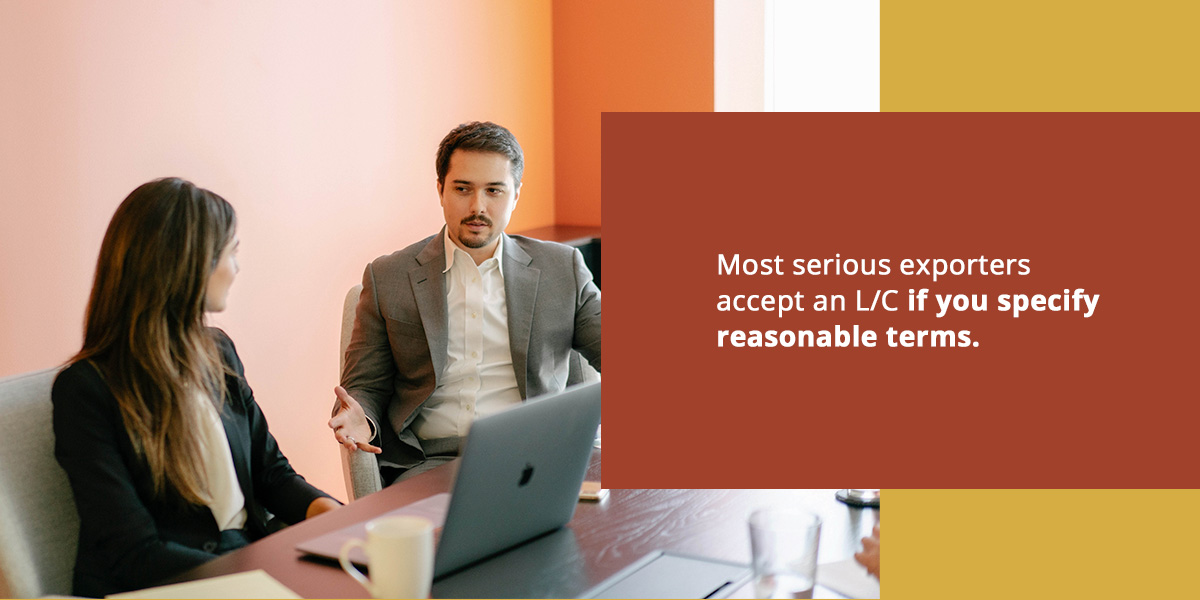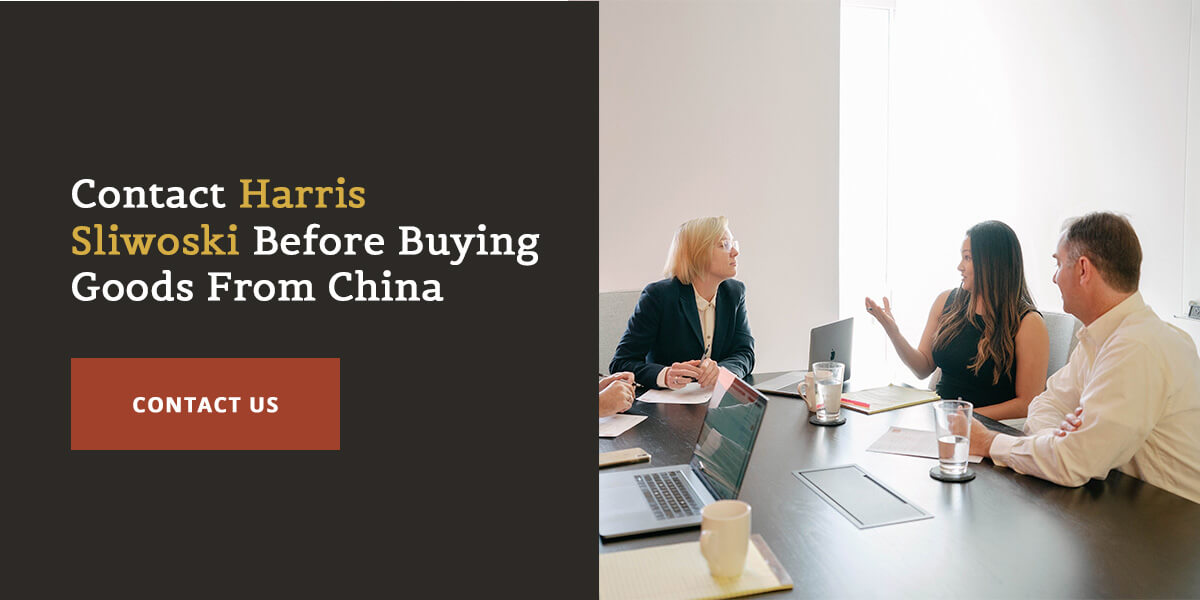Contents of this Article:
- Find a Suitable Supplier
- Clearly Define Your Expected Product
- Negotiate Reasonable Payment Terms
- Control Your Product Quality in the Factory
- Formalize the Process
- Contact Harris Sliwoski Before Buying Goods From China
Met recently with Renaud Anjoran in Shenzhen. Renaud is the founder of Sofeast, a quality assurance firm that assists foreign companies with China product sourcing and quality control. Renaud has been in Shenzhen since 2006 and he writes the Quality Inspection Blog, of which I have been a huge fan for a long time.
During our dinner, we talked about how a company buying product from China is “only as good as” its weakest link among supplier selection, payment terms and penalties, quality control, communication and manufacturing contract. Therefore, to succeed, you need an integrated strategy from the start. I asked Renaud to co-write this post with me and the below is that.
When purchasing in China, the following are the five basic steps you should take to maximize your likelihood of getting good quality products. .
1. Find a Suitable Supplier
Does this sound familiar? You find a sample at a trade show and get a good quote from the company you think manufactured it. Your search is over and you’re all set.
Though this method seems quick and easy, it is a risky way to choose your supplier. Online directories (e.g. Alibaba) and trade shows should be only a starting point. Suppliers pay to be listed or to exhibit, and they are not rigorously screened.
Always conduct a due diligence background check on any suppliers you consider purchasing from to verify the claims they make. That background check isn’t enough, though. You or someone you trust should also go see the factory. Try to get some customer references and call them. Make sure the factory is familiar with your market’s regulatory standards.
If your orders are small, avoid large manufacturers because they will probably quote high prices and not care about your orders. Smaller factories usually need closer monitoring, especially on the first production run.
Be forewarned: showing a nice factory and then subcontracting production to a smaller workshop is very common and the source of many quality problems. Your contract with your supplier should prohibit subcontracting.
2. Clearly Define Your Expected Product
Some buyers approve a pre-production sample and a pro forma invoice and then wire the deposit. This is not enough. When you purchase from China, you need to make sure you have answers to the following:
- Does the product comply with your own country’s safety standards?
- How will it be labeled?
- Will the packaging be strong enough to protect your goods during shipment?
These are just some of the many things on which you and your supplier should reach a written agreement before money changes hands.
I worked with an American importer who told its Chinese supplier that “the quality standard should be the same as that of your other U.S. customers.” Of course, when this American importer started experiencing problems, the Chinese supplier replied by claiming that “our other U.S. customers never complain about this, so it is not a problem.”
You need to write your product expectations in a detailed specification sheet that leaves no room for interpretation. Your methods for measuring and testing these specifications, along with the tolerances, should be included in this document. And your contract should set forth specific dollar penalties if the specifications are not met.
If you are developing a new product with a Chinese manufacturer, document the resulting product’s characteristics and production processes as you cannot count on your supplier to give you this information if you end up switching factories later on.
3. Negotiate Reasonable Payment Terms
The most common payment method is T/T (Bank Transfer). The standard terms are a 30% deposit before the components are purchased, with the remaining 70% to be paid after the supplier faxes the bill of lading to the importer. It can get a bit more complex if a mold or special tooling is necessary during development.
Be wary of vendors who want more favorable terms. They usually want to trap you. I worked with a buyer who was so confident he would receive a good product he paid the full price before production. Needless to say, delivery came late and there were quality problems.
Since he had already paid, he had no leverage or option for pursuing corrective action.
Another method is paying by irrevocable L/C (Letter of Credit). Most big exporters accept an L/C if you specify reasonable terms. Smaller exporters, not so much.
You can send the draft to your supplier for approval before the letter is formally “opened” by your bank. Bank fees are higher than when you pay via T/T, but you have more protection.
4. Control Your Product Quality in the Factory
You can make sure your supplier meets your product specifications by visiting the factory yourself or hiring a third-party inspection firm to manage this process for you.
The most common type of quality control (QC) is a final random inspection of a statistically valid sample. This statistically valid sample gives professional inspectors enough to quickly and cost-effectively draw conclusions about an entire production run.
In some cases, quality control needs to happen early on to catch problems before production is complete. In these cases, an inspection should take place either before the components are embedded in the final goods or when the first finished products just get off the lines. In these cases, some samples can be picked up and sent for lab testing.
To take full advantage of QC inspections, you should first have defined the product spec sheet. The spec sheet is your inspector’s checklist. Your payments should also be tied to quality approvals. If you pay by T/T, you should not wire the remainder of your payment until your product passes final inspection. If you pay by L/C, the documents required by your bank should include a certificate of quality control issued by your appointed QC firm.
5. Formalize the Process
Most importers are not aware of two facts. First, it is possible for an importer to sue a Chinese supplier, but it only makes sense to do it in China — unless that supplier owns assets in another country. Second, your purchase orders will aid in your supplier’s defense; they almost certainly will not help you.
To minimize your risks, you should buy your product pursuant to an original equipment manufacturer (OEM) agreement. Ideally, the agreement will be in Chinese. This contract will decrease your chances of problems. It also gives you more leverage if a problem occurs.
You also should be sure to put this entire system in place before you start negotiating with potential suppliers. Doing this will let them know that you are a professional importer and this will make them more likely to agree to your requests because they will know that you can easily find another supplier. Perhaps most importantly, it will be more difficult and less effective if you start scrambling to put this system in place after you have already placed your order.
Contact Harris Sliwoski Before Buying Goods From China
Harris Sliwoski does the heavy lifting so you don’t have to, whether you’re manufacturing internationally or you’re looking to do business overseas. If you need help developing a strategy for working with suppliers in China, we’ve got you covered. Contact us today to learn more.




























